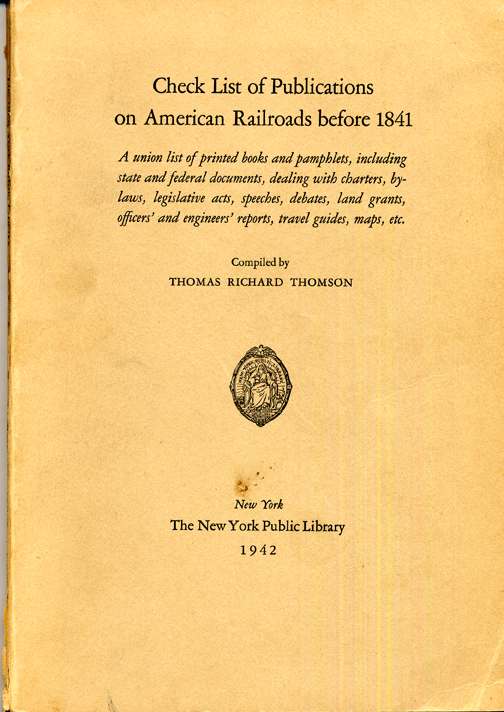A New AED Source: Early Railroad Literature
- by Bruce E. McKinney

A Collector's Gem
By Bruce McKinney
In 1942 the New York Public Library issued a 250 page catalogue on early books and other printed materials relating to the development of the railroad in the United States. It's a gem and we have added it both to the Americana Exchange Database and have created a Wiki Bibliography based on it. There are 2,865 entries for the period 1800 to 1840. It's a remarkable picture of early railroad development.
The 1841 cut-off seems to almost predate railroads but it turns out interest in rights-of-way and rail systems based on pre-steam power made the subject of "rail roads" a well-developed idea by 1840. The explosion in railroad construction, a national obsession to build railroads to connect almost every burg, village, town, city and port, would begin in earnest to take hold in the 1840's and lead to widespread railroad bankruptcies in the 1870's. In time many branch and feeder lines would be consolidated into the trunk systems from which the major 20th century American railroads emerged.
In the mid 19th century American population was mostly rural and there seemed to be little expectation among railroad promoters that, rather than simply connecting the countryside to cities, railroads would facilitate city migration. It turned out to be more of a one way street than most expected because [1] increasing farm efficiency reduced the labor component per bushel and gallon and [2] the developing industrial economy created better paying jobs in metropolitan areas. For many, once they saw city life, there was no going back except for the occasional visit. The mass exodus, already underway, would accelerate with the easy access and egress that railroads provided but more and more of the tickets would be one way. With the coming of the automobile even the trunk lines, that succeeded the initial panoply of branch lines, would begin to fail. Peoples' commitment was to convenience and all forms of transportation simply a means. Today the few feeder lines that still exist and offer coach service are novelties, Sunday excursions for holiday seekers.
This source captures a fair picture of the development of railroads in America as it enters the industrial age. The sources identified, begin in 1800 with references to the first efforts to transport by rail if not yet by steam power. Fulton applied steam, as a source of power, to boats in the first decade of the nineteenth century. George Stevens, of New Jersey, did the same for the railroad in 1826. By the early 1830's, demonstration railroads were operating in half a dozen states. By mid-decade, the railroad as corporation was emerging. By 1840 the nation was on the verge of transformation from an agricultural to an industrial economy. The railroads would turn out to be merely relay runners on a race on which they ran a single lap. In their time they were essential but soon expendable and it quickly turned out that most towns had too little to send out or bring in to justify the capital and labor involved. What no town was willing to live without in the 1850s and 1860s soon became failed investments in the 1870s.